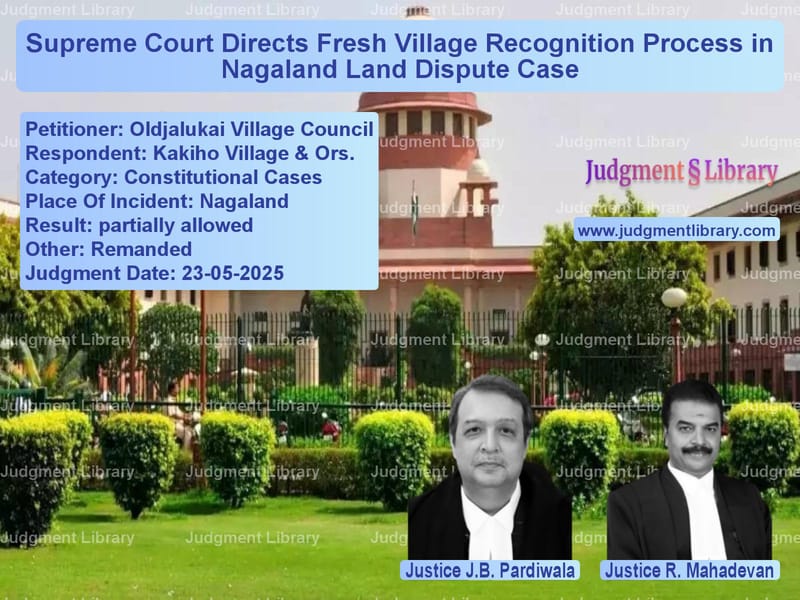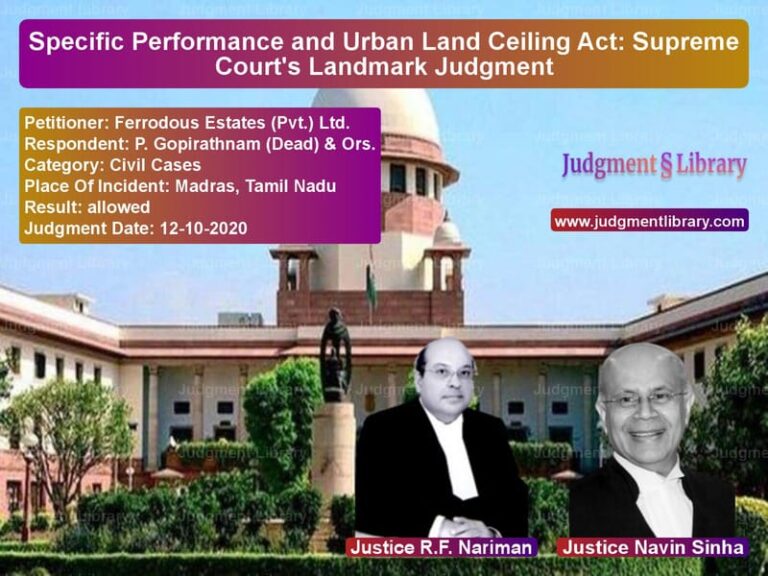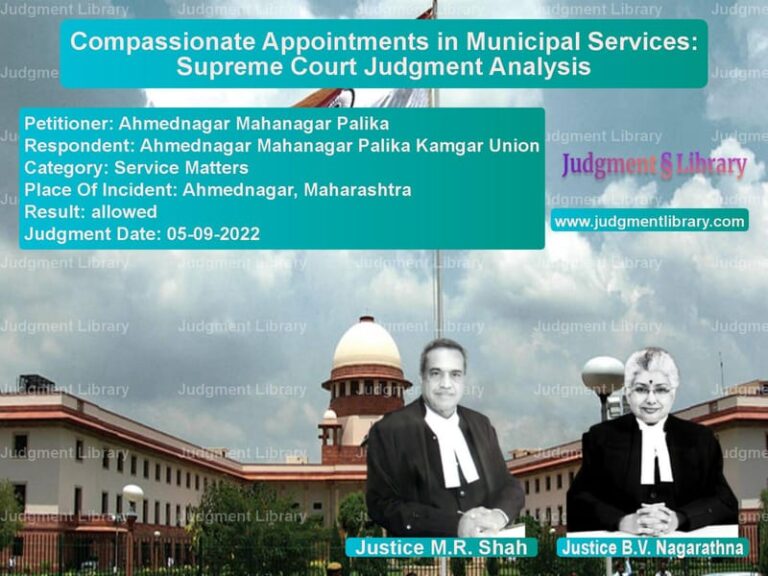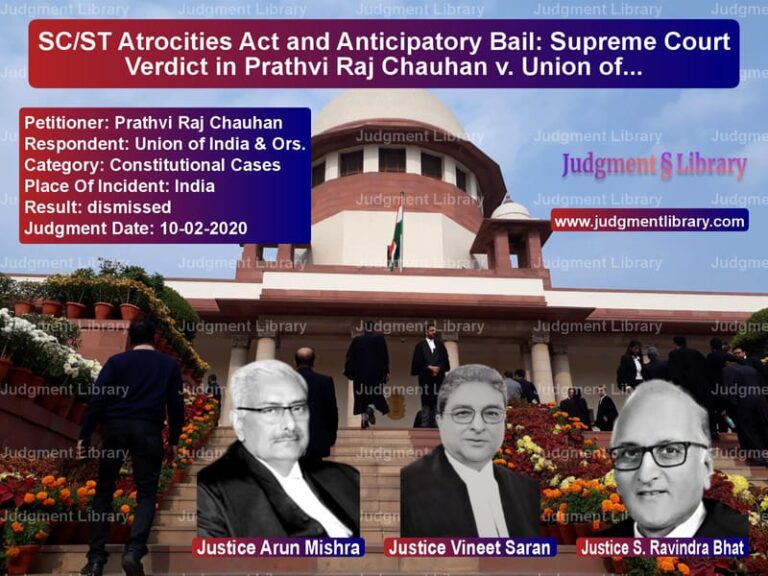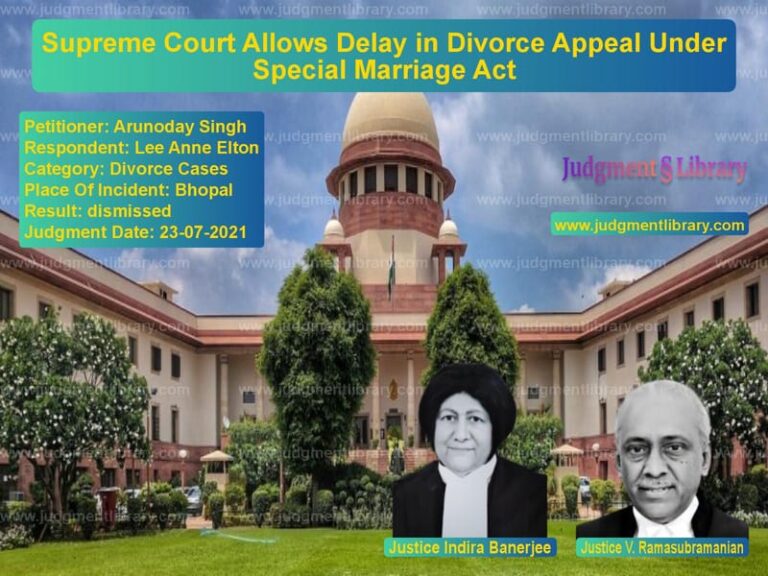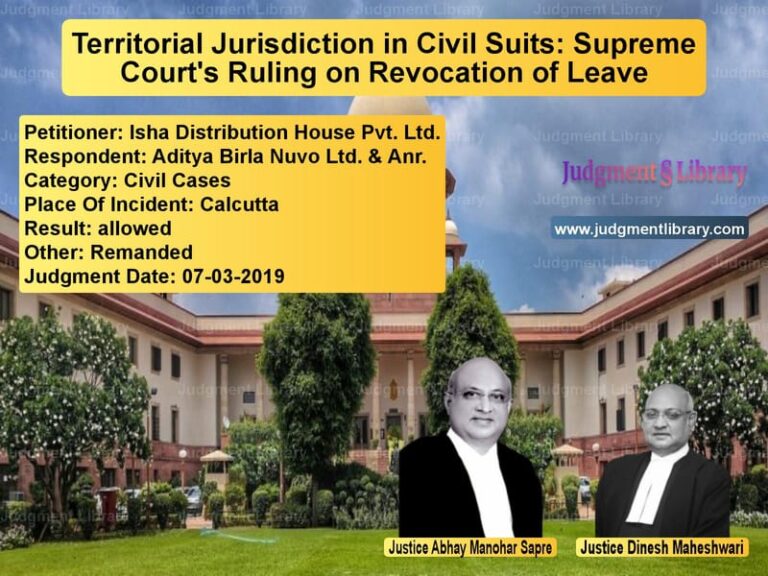Supreme Court Directs Fresh Village Recognition Process in Nagaland Land Dispute Case
In the picturesque hills of Nagaland, where land represents not just property but identity, culture, and heritage, a legal battle over village recognition has reached the nation’s highest court. The case of Oldjalukai Village Council versus Kakiho Village & Others represents a complex interplay between traditional customs, constitutional provisions, and administrative procedures that has kept a village in legal limbo for nearly two decades. This dispute, which finally reached the Supreme Court in 2025, highlights the unique challenges of governance in India’s northeastern states where customary laws and modern administration must find a delicate balance.
The heart of this conflict lies in the recognition of Kakiho Village, which was allegedly established on September 1, 2007, by respondents affiliated with the Sumi tribe. The appellant, Oldjalukai Village Council, belonging to the Zeliangrong tribe, claims that Kakiho Village was established on their ancestral land without following proper procedures or obtaining the necessary No Objection Certificate as required by Nagaland’s customary practices and official government memorandums. What began as a local dispute over land ownership gradually escalated into a legal battle that would test the boundaries of Article 371A of the Constitution, which grants special protections to Nagaland’s customary laws and practices.
The Complex Web of Nagaland’s Land System
To understand this case, one must first appreciate the unique nature of land ownership in Nagaland. As the Supreme Court noted, “Land is one of the priceless assets for the people of Nagaland and forms an inalienable part of their identity and life.” Unlike other states in India, Nagaland’s landholding system is non-cadastral, meaning it’s not systematically surveyed and registered. Each district is primarily occupied by specific tribes with distinct socio-cultural characteristics, and land is either owned communally by a clan or village or by individuals.
The formation and recognition of villages in Nagaland are deeply rooted in customary traditions. When a new village is established on land ancestrally owned by another village, the prevailing custom requires the parent village to accord consent through a No Objection Certificate. This custom found official recognition in the Office Memorandum dated March 22, 1996, issued by the Nagaland government, which laid down specific criteria for village recognition.
The 1996 OM stipulated several conditions, including that a new village must have at least 50 houses with a population of not less than 250 people, sufficient land for expansion and agriculture, and be constituted by indigenous inhabitants only. Most importantly, Condition (v) required that “a new village constituted by members of more than one village in a different location but within the ancestral land of the parent village, should obtain from the Village Council Chairman of the parent village a ‘No Objection Certificate’ indicating the boundaries of the new village.”
This was supplemented by another OM dated October 1, 2005, which introduced the requirement of a public notice providing a 30-day period for objections regarding the proposed village recognition.
The Legal Journey Through the Courts
Kakiho Village began its quest for recognition in 2009 when it submitted an application to the Deputy Commissioner of Dimapur. The spot verification report submitted on September 10, 2009, indicated that Kakiho Village admeasured 1012 acres, with a population of 300 people and 57 households, falling under the Dhansiripar sub-division of Dimapur district. The report claimed the village had no boundary disputes with neighboring villages.
However, when the public notice was issued on October 13, 2009, Oldjalukai Village Council promptly raised objections on October 16, 2009, claiming that Kakiho Village was established on their ancestral land. Despite these objections, the Deputy Commissioner of Dimapur recommended recognition on November 18, 2009.
The matter reached the Nagaland Cabinet, which on December 14, 2011, approved the recognition of 34 villages, including Kakiho Village, but subject to joint verification by the Deputy Commissioners of Peren and Dimapur districts. After joint verification, the Deputy Commissioner of Dimapur reaffirmed that Kakiho Village fell within Dimapur District, while the Deputy Commissioner of Peren refrained from offering any conclusive opinion, citing the inter-district boundary dispute.
Frustrated by the delay, Kakiho Village approached the Gauhati High Court’s Kohima Bench, which directed the state to issue formal recognition orders within three months. The High Court observed that “the inter-district boundary dispute would have no bearing insofar as recognition of the petitioner’s village is concerned.” The state’s appeal resulted in an extension of the timeline by four months but essentially upheld the single judge’s direction.
Oldjalukai Village Council, claiming they were necessary parties but not impleaded in the High Court proceedings, approached the Supreme Court through a special leave petition.
Arguments Before the Supreme Court
Before the Supreme Court bench comprising Justice J.B. Pardiwala and Justice R. Mahadevan, Mr. Parthiv K. Goswami, learned Senior Counsel for Oldjalukai Village Council, presented a multifaceted argument. He contended that “the appellant was a necessary and proper party in the adjudication of the dispute before the High Court on account of the fact that the respondent no. 1 village falls within their ancestral land and that they had also filed objections to the Public Notice dated 13.10.2009.”
Goswami emphasized that “the issue of granting recognition to a village falls within the domain of the executive decision making. It is well settled that in exercise of the power of judicial review, a writ court can only examine the decision-making process, and not substitute the decision under consideration with its own decision.” He argued that once the state government/cabinet had decided to keep recognition in abeyance after considering relevant factors, the High Court erred in issuing a mandamus.
The counsel highlighted the importance of customary practices, arguing that “the establishment and recognition of a new village on ancestral land of another village results in transfer of ownership of the land to the newly created village. It is for this reason that upon the establishment of a new village on a land which ancestrally belongs to another village, the prevailing custom requires a ‘No Objection Certificate’ of the parent/ancestral village.”
Goswami placed significant emphasis on Article 371A of the Constitution, which he stated “inter alia recognizes the importance of safeguarding the social practices of the Nagas along with the customary laws and traditions existing in the region by specifically excluding any law made by the Parliament in respect of certain matters from application in the State of Nagaland, unless a resolution to that effect is passed by the Legislative Assembly.”
On the other side, Ms. Renuka Sahu, learned counsel for Kakiho Village, argued that Oldjalukai was not a necessary party in the High Court proceedings. She contended that while objections were raised, “the Office of the Deputy Commissioner, Dimapur had replied to the same vide its communication dated 08.11.2009 and directed the appellant to provide additional and sufficient details to back their claim that the respondent no. 1 village would fall within the boundary of their ancestral land. However, it was the appellant who has failed to produce any such document. Therefore, naturally, the objections raised by the appellant were nullified.”
Sahu emphasized that Kakiho Village had “duly complied with all the formalities for the recognition of a new village as required by the O.M.’s dated 22.03.1996 and 1.10.2005,” including obtaining No Objection Certificates from neighboring villages, submitting survey reports, and undergoing joint verification.
Perhaps most compellingly, Sahu argued that the fundamental rights of Kakiho villagers were being violated due to their unrecognized status. She detailed how this deprived them of access to various government schemes and facilities, including Village Development Board benefits, road construction, healthcare infrastructure, schools, food security schemes, and agricultural support. She contended that “the fundamental rights and Directive Principles of State Policy under Parts III and IV of the Constitution respectively, form the bedrock of our Constitution and cannot be over-shadowed by Article 371A or any other customary law of the State, since the rule of law and constitutional supremacy must remain paramount.”
The State of Nagaland, represented by Ms. Enatoli Sema, highlighted the complex inter-district boundary issues and various committee reports, including the Ezong Committee Report of 2002 and a Cabinet Sub-Committee Report of 2021. The state emphasized its efforts to amicably resolve the dispute while maintaining peace between communities.
The Supreme Court’s Analysis and Ruling
The Supreme Court delivered a nuanced judgment that balanced the competing interests while emphasizing procedural compliance. The Court began by acknowledging the special status of Nagaland under Article 371A, noting that “the insertion of Article 371A was the outcome of a political settlement which culminated after a decade-long struggle and is also a reflection of the grant of the right to ‘self-rule’ and political autonomy to the people of Nagaland.”
The Court extensively analyzed the Nagaland Village and Area Councils Act, 1978, particularly Section 3, which defines a village and sets conditions for recognition. The Court observed that “a great amount of emphasis is placed primarily on two things – One, ownership of the land, either communally by the village as a whole or individually by the members of the village; and two, the adherence to the existing customary practices in the process of ‘recognition’ of the village.”
Regarding the Office Memorandums of 1996 and 2005, the Court noted that “the idea of consent and communication between all the relevant stakeholders is cardinal and fundamental to the process of village recognition.” The Court emphasized that “it is the bounden duty of the State and its relevant authorities to adequately and appropriately consider any and all such objections which may be raised by the interested parties in response to the public notice issued by them, provided that they are lodged within the stipulated time-period. Otherwise, the very object of issuing a public notice would be vitiated.”
The Court found that in Kakiho’s case, “it is unclear as to what extent the aforesaid communication made by the appellant was considered by the Deputy Commissioner, Dimapur before additional steps were taken to forward the proposal for recognition of the respondent no. 1 village to the government.” The State had not made any averment regarding the merits of Oldjalukai’s claims, leaving the Court “at a loss to understand how it can be contended, both by the State of Nagaland and by the respondent nos. 1 and 2 respectively, that the conditions/criteria laid down in the two O.M.’s, especially the latter O.M. dated 01.10.2005, were fulfilled in the present case.”
On the issue of the inter-district boundary dispute, the Court conducted a detailed examination of various committee reports and concluded that “when the Ezong Committee Report was published in the year 2002, the respondent no. 1 village was not inaugurated or established yet. Hence, there is every possibility that the State authorities attributed the persisting inter-district dispute as a bona fide reason for keeping the recognition of the respondent no. 1 village in abeyance, largely due to the absence of clarity on the bounds of the respondent no. 1 village and whether it fell within the disputed area or not. However, post the year 2021, i.e., it was obvious and plain as day that the boundary dispute had nothing whatsoever to do with the case of the respondent no. 1 village.”
The Court expressed frustration with the state’s delay, noting that “we are equally baffled and frustrated with the enormous reluctance that the State has exhibited in considering the merits of the objections of the appellants and putting an end to this issue.”
The Court’s Final Directions
In its concluding remarks, the Supreme Court set aside the High Court’s observations regarding compliance with the Office Memorandums, “solely because the High Court while passing the impugned decision, was not alive to the case of the appellant herein.”
The Court then issued specific directions: “The State authorities are directed to re-issue a public notice regarding the recognition of the respondent no. 1 village and exhaustively consider all the objections which may be raised from every quarter, including that of the appellant herein. A period of six months is provided to the State to complete the said process and take a call on whether recognition must be granted to the respondent no. 1 village or not. Non-adherence to this timeline would be viewed strictly.”
The Court also kept the matter as part-heard, directing the Registry to list it before the same bench after six months for compliance monitoring.
Broader Implications
This judgment represents a significant development in the interface between customary laws and constitutional governance in India’s northeastern states. By emphasizing the importance of following established procedures while also setting strict timelines for decision-making, the Supreme Court has balanced respect for Nagaland’s unique constitutional status with the need for administrative efficiency and protection of fundamental rights.
The case highlights the continuing relevance of Article 371A in protecting the distinctive cultural and social practices of Nagaland while also demonstrating that constitutional provisions protecting customary laws cannot be used to indefinitely delay administrative decisions that affect people’s fundamental rights and access to essential services.
For the residents of Kakiho Village, the judgment offers hope that their nearly two-decade wait for formal recognition might soon conclude. For Oldjalukai Village Council, it ensures that their objections will be properly considered. And for the Nagaland administration, it serves as a reminder that while complex inter-community disputes require careful handling, they cannot be postponed indefinitely without violating constitutional principles and administrative responsibilities.
As the six-month timeline progresses, all stakeholders will be watching closely to see how the Nagaland government navigates this delicate balance between tradition and modernity, between customary practices and constitutional obligations, in resolving this long-pending dispute.
Petitioner Name: Oldjalukai Village Council.Respondent Name: Kakiho Village & Ors..Judgment By: Justice J.B. Pardiwala, Justice R. Mahadevan.Place Of Incident: Nagaland.Judgment Date: 23-05-2025.Result: partially allowed.
Don’t miss out on the full details! Download the complete judgment in PDF format below and gain valuable insights instantly!
Download Judgment: oldjalukai-village-c-vs-kakiho-village-&-ors-supreme-court-of-india-judgment-dated-23-05-2025.pdf
Directly Download Judgment: Directly download this Judgment
See all petitions in Fundamental Rights
See all petitions in Constitution Interpretation
See all petitions in Property Disputes
See all petitions in Reservation Cases
See all petitions in Public Interest Litigation
See all petitions in Judgment by J.B. Pardiwala
See all petitions in Judgment by R. Mahadevan
See all petitions in partially allowed
See all petitions in Remanded
See all petitions in supreme court of India judgments May 2025
See all petitions in 2025 judgments
See all posts in Constitutional Cases Category
See all allowed petitions in Constitutional Cases Category
See all Dismissed petitions in Constitutional Cases Category
See all partially allowed petitions in Constitutional Cases Category

